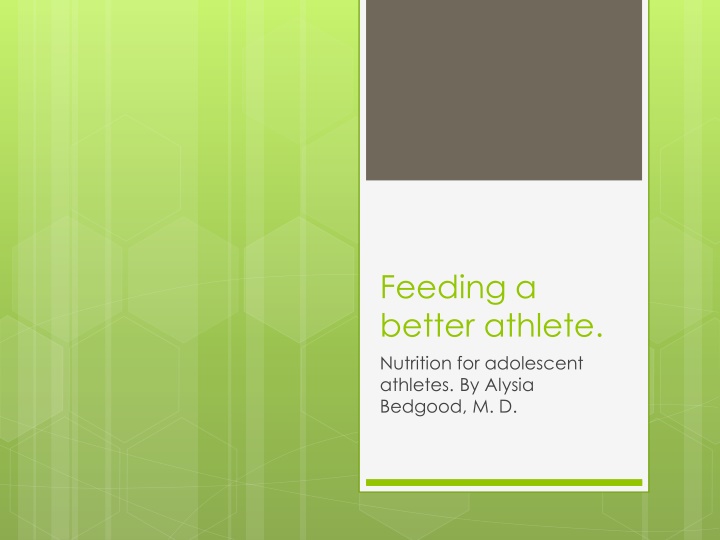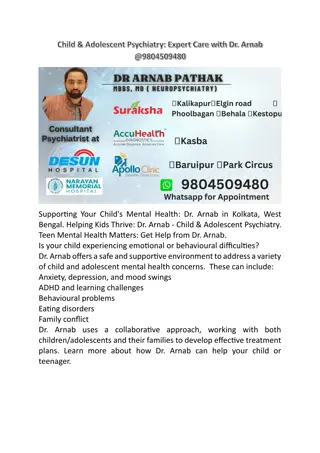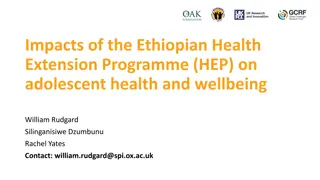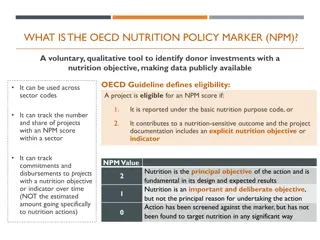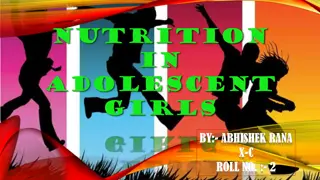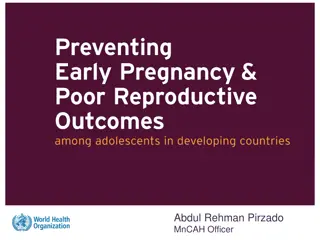Nutrition Essentials for Adolescent Athletes
Uncover the fundamentals of nutrition for adolescent athletes, including the importance of carbs, protein, and fat, calorie requirements based on activity level, and the distinction between anaerobic and aerobic exercise. Learn how to tailor meals, hydration, and nutrient intake to support optimal athletic performance, recognizing that every athlete is unique and may have different dietary needs.
Download Presentation

Please find below an Image/Link to download the presentation.
The content on the website is provided AS IS for your information and personal use only. It may not be sold, licensed, or shared on other websites without obtaining consent from the author.If you encounter any issues during the download, it is possible that the publisher has removed the file from their server.
You are allowed to download the files provided on this website for personal or commercial use, subject to the condition that they are used lawfully. All files are the property of their respective owners.
The content on the website is provided AS IS for your information and personal use only. It may not be sold, licensed, or shared on other websites without obtaining consent from the author.
E N D
Presentation Transcript
Feeding a better athlete. Nutrition for adolescent athletes. By Alysia Bedgood, M. D.
Outline The basics Meals Quantity Quality Timing Hydration Quantity Quality Timing Other nutrients Meal examples
The basics Every food is made up of carbs, protein and fat. Carbohydrates and protein each have 4 calories per gram. Fat has 7 calories per gram.
Why do we need all three? Anaerobic exercise is an exercise intense enough to trigger lactic acid formation. It is used by athletes in non-endurance sports to promote strength, speed and power and by body builders to build muscle mass. Muscle energy systems trained using anaerobic exercise develop differently compared to aerobic exercise, leading to greater performance in short duration, high intensity activities, which last from mere seconds to up to about 2 minutes. Sprinters, weight lifters Uses stored sugar.
Aerobic exercise refers to the use of oxygen to adequately meet energy demands during exercise via aerobic metabolism. Generally, light- to-moderate intensity activities that are sufficiently supported by aerobic metabolism can be performed for extended periods of time. The intensity should be between 60 and 85% of maximum heart rate. Cross country runners and skiers. Uses both sugar and fat.
Calories Sedentary: Lots of TV and videogame time, some exercise. Moderate: 10-30min of exercise 3 times per week. Very active: 2.5 hours of recreational activity 4 or more times per week. Sedentary 9-13 yo 14-18 yo Girls 1600 1800 Boys 1800 2200 Moderately active 9-13 yo 14-18 yo Girls 1800 2000 Boys 2000 2400 Very active 9-13 yo 14-18 yo Girls 2000 2200 Boys 2200 2600
Its not hard to get calories.
Examples 10 year old that is 4 ft 6 inches 13 year old that is 5 ft 1 inch or Overweight/muscular 10 year old 15 year old that is 5 foot 9 inches or Overweight/muscular13 year old 70lb child 100lb child 130lb child
Carbohydrates Fruits, breads, cereal, pasta, potatoes. This should be what kids are getting most of. 55% of daily calories or 5-8g/kg. That means: 70lb child-160-250g/day (4 slices of bread, 2 bananas, 1 20oz gatorade) 100lb child- 225-360g/day (4 slices of bread, 2 bananas, 2 gatorades and 1 c mac & cheese) 130lb child- 295-470g/d (4 slices of bread, 2 bananas, 2 gatorades, 1 c mac & cheese, 1 c mashed potatoes, 1 c ice cream)
Protein Meats, seafood, beans, tofu, mushrooms Kids don t have the ability to grow large muscles until after puberty so don t need a ton of this. 10% of calories or 0.85-0.95g/kg/day That means: 70lb child- 27-30g/day (1/2 c grilled chicken and quarter pound burger patty) 100lb child- 38.5-43g/day (1/2 c grilled chicken, 1 quarter pound burger patty, and 2 eggs) 130lb child- 50-56g/day (1/2 c grilled chicken, 1 quarter pound burger patty, 2 eggs, 1 c beans)
Fat Fried food, meat, dairy, avocados, nuts, oils Do not worry about getting too little, DO worry about getting too much. 25-30% of calories (but there are more calories per gram) That means: 70lb child- 60-68g/day* (4 tbsp peanut butter, 3 eggs, 2.5 slices of cheese) 100lb child- 68-75g/day* (4 tbsp peanut butter, 3 eggs, 2.5 slices cheese, and 1 quarter pound burger patty) 130lb child- 75-83g/day* (4 tbsp peanut butter, 3 eggs, 2.5 slices cheese, 1 quarter pound burger patty, and 3 chicken mcnuggets)
Recommendations Most kids have no problems getting there calories in but they do not all get them in a healthy way.
Why are high quality foods important? Sugar crash Easily absorbed sugars (think candy and desserts) causes a quick spike in blood glucose then a dramatic drop. Hyperactivity/Obesity High sugar and high fat foods are closely related to childhood obesity and may be associated with some hyperactivity. Nutrients High quality foods are more nutrient dense and therefore help kids to grow properly well not just big. Teaching good habits We are shaping these kids minds and bodies. Overweight and obese children are more likely to grow up to be overweight and obese adults.
When to eat whatbefore Before exercise- high carb, moderate protein, low fat, low fiber. Want things that are easy to digest and won t upset stomachs. Base on how long and strenuous activity will be. Some kids have nervous stomachs on game day.
During During exercise (halftime)- ~ 30 g per hour of continuous activity. If just standing on the sidelines do not need as much as those playing the whole game. Similar to pre-exercise or even higher carb, lower fat and protein. Quick energy (fruits like oranges, watermelon, grapes, gatorade)
After After exercise- need to replenish what energy (glucose/glycogen) was used up and rebuild muscle. Spread carbohydrates and protein from immediately after to 6 hours after. Recent studies show benefit of having a few grams of protein before bedtime in helping to gain muscle for teens and adults.
Examples (snacks) Fruit and yogurt Cereal and milk Trail mix with nuts and raisins Lunch meat sandwich Cheese and crackers
Hydration! Most kids do not drink enough. Smaller bodies have more surface area to body mass ration so actually lose more water for size. Houston is HOT! Salty sweaters Medications like Adderall and allergy medication can increase dehydration. If kids wait until they are thirsty it is to late. Performance is affected when someone becomes 2-3 percent dehydrated. Some kids (salty sweaters) are more prone to fluid and electrolyte loss than others.
How much is enough? 9-13 year olds require 50+oz (7-8 glasses) 14-18 year olds require 60+ (8-9 glasses) Beverages with large amounts of sugar or caffeine count against this amount. Caffeine and high amounts of sugar cause increased urination and more loss of fluids than normal.
But water is boring Sports drinks are good for events longer than one hour. Should include 4-8% carbs as well as sodium. Milk is also good after activity since it has hydration, carbs and protein.
When and how? The best time to hydrate is before activity. 1 hour before Incorporating water and high fluid foods (soups, fruits) Water- 4-8oz (6- 12 year olds) 8- 16oz (13-18 year olds Water or sports drink- 5-10oz for any age Water or sports drink- 16- 24oz/lb lost Every 20 minutes of activity After activity
Other important notes. All kids need calcium for good bone health. Age 9 and older need 3 c milk or equivalent calcium. Most adults and especially kids do not require supplements for proper growth.
The buzz Caffeine not only causes dehydration but can lead to heart problems such as arrhythmias in high doses. Can increase fatigue and cause withdrawals. Recommendation is no more than 100mg/day. Common amounts: 16 ounces of Monster energy drink: 160 9.5 ounces of Starbucks Frappuccino: 115 8.4 ounces of Amp energy drink: 74 12 ounces of Mountain Dew: 54 16 ounces of Snapple (peach): 42 12 ounces of Coca-Cola: 35 8 ounces of hot cocoa: 9
Sample diet 10 yo Breakfast- 2, 4 inch round pancakes, 1/2 c. 1% milk, 1 c. blueberries Lunch- Sandwich (2 slices of bread, 1.5 slices lean turkey, lettuce, tomato, tbsp mayo), medium apple, 2 tbsp peanut butter. Pregame- 1, 20oz gatorade and 1 c orange sections. Game time- water Half time- goldfish crackers (55 pieces), 1, 20oz gatorade Dinner- c. homemade lasagna with meat sauce, 1 slice white bread, c vanilla ice cream. Before bed snack- 2 bon bel cheese Totals: 1,815 calories, 317g carbs, 65g fat, 67g protein
Sample diet 13 yo Breakfast- 2, 4 inch round pancakes, 1 c. 1% milk, 1 c. blueberries Lunch- Sandwich (2 slices of bread, 3 slices lean turkey, lettuce, tomato, tbsp mayo), medium apple, 2 tbsp peanut butter. Pregame- 1, 20oz gatorade and 1 c orange sections. Game time- water Half time- goldfish crackers (55 pieces), 1, 20oz gatorade Dinner- 1 c. homemade lasagna with meat sauce, 1 slice white bread, c vanilla ice cream. Before bed snack- 2 bon bel cheese Totals: 2,024 calories, 334g carbs, 74g fat, 83g protein
Sample diet 15 yo Breakfast- 3, 4 inch round pancakes, 1 c. 1% milk, 1 c. blueberries Lunch- Sandwich (2 slices of bread, 3 slices lean turkey, lettuce, tomato, tbsp mayo), medium apple, 2 tbsp peanut butter. Pregame- 1, 20oz gatorade and 1 c orange sections. Game time- water Half time- goldfish crackers (55 pieces), 1, 20oz gatorade Dinner- 1 c. homemade lasagna with meat sauce, 1 slice white bread, c vanilla ice cream. Before bed snack- 3 bon bel cheese Totals: 2,262 calories, 357g carbs, 84g fat, 96g protein
Resources http://www.usada.org/resources/nutrition/?gclid=Cj0 KEQjw_42eBRDHqcG1psmtneEBEiQAWPL8WMv6- 2BiLKwCJqCsaaombmpZz3IJzhbS_8kfFlTQdQYaAmDY 8P8HAQ (U.S. Anti-doping agency) http://www.todaysdietitian.com/newarchives/01101 2p14.shtml (Today s dietician) file:///C:/Users/abedgood/Desktop/Hydration-in- Teenagers.pdf (National hydration council) http://www.ocde.us/hydration/documents/hydration _tips.pdf http://www.washingtonpost.com/blogs/on- parenting/post/why-caffeine-is-bad-for-your- kids/2012/05/23/gJQAH7fSlU_blog.html
